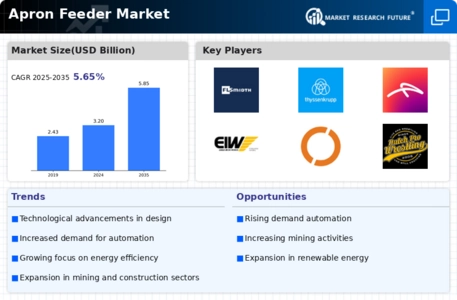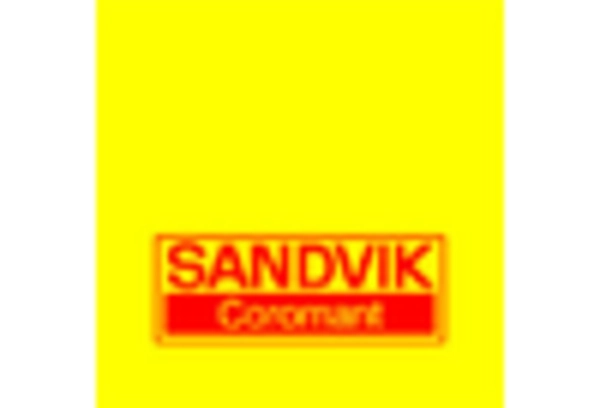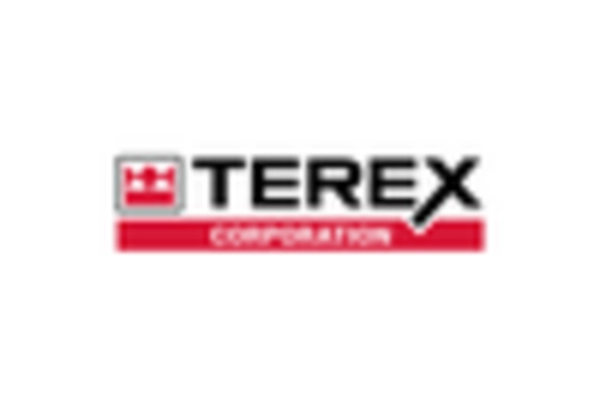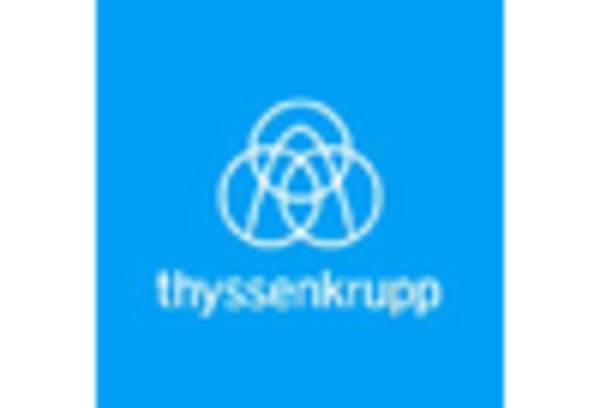Increased Demand in Mining Sector
The Apron Feeder Market is experiencing heightened demand primarily due to the mining sector's expansion. As mineral extraction activities intensify, the need for efficient material handling solutions becomes paramount. Apron feeders are recognized for their ability to handle large volumes of heavy materials, which is essential in mining operations. According to recent data, the mining industry is projected to grow at a compound annual growth rate of approximately 5% over the next few years. This growth is likely to drive the adoption of apron feeders, as they provide reliable and continuous material flow, thereby enhancing operational efficiency. Furthermore, the increasing focus on automation in mining operations may further bolster the apron feeder market, as these systems can be integrated with advanced technologies to optimize performance.
Infrastructure Development Initiatives
Infrastructure development initiatives across various regions are significantly influencing the Apron Feeder Market. Governments are investing heavily in infrastructure projects, including roads, bridges, and railways, which necessitate the use of robust material handling equipment. Apron feeders are particularly suited for these applications due to their durability and capacity to manage bulk materials. Recent reports indicate that infrastructure spending is expected to rise, with estimates suggesting an increase of over 10% in certain regions. This surge in infrastructure projects is likely to create a favorable environment for apron feeder manufacturers, as construction activities require reliable feeding solutions to ensure smooth operations. Consequently, the apron feeder market may witness substantial growth as these projects unfold.
Technological Integration and Automation
Technological integration and automation are reshaping the Apron Feeder Market, as manufacturers seek to enhance the efficiency and reliability of their products. The incorporation of advanced technologies, such as IoT and AI, allows for real-time monitoring and predictive maintenance of apron feeders. This shift towards smart systems is likely to improve operational efficiency and reduce downtime, which is critical in industries that rely on continuous material flow. Recent studies indicate that the adoption of automation in material handling is expected to grow by over 15% in the coming years. As industries increasingly prioritize efficiency and cost-effectiveness, the apron feeder market may see a surge in demand for technologically advanced solutions that can seamlessly integrate into existing operations.
Focus on Energy Efficiency and Sustainability
The Apron Feeder Market is witnessing a growing emphasis on energy efficiency and sustainability, driven by environmental regulations and corporate responsibility initiatives. Companies are increasingly seeking equipment that minimizes energy consumption and reduces carbon footprints. Apron feeders, designed with energy-efficient features, are becoming more attractive to industries aiming to comply with sustainability standards. Market trends suggest that the demand for energy-efficient material handling solutions is likely to rise, with projections indicating a growth rate of around 8% in this segment. This focus on sustainability not only aligns with regulatory requirements but also enhances the reputation of companies within their respective industries. As a result, apron feeder manufacturers may need to innovate and develop products that meet these evolving demands.
Rising Demand in Cement and Aggregates Industry
The cement and aggregates industry is a crucial driver for the Apron Feeder Market, as these sectors require efficient material handling systems to manage raw materials. The demand for cement is projected to increase due to urbanization and population growth, leading to a rise in construction activities. As a result, apron feeders are becoming increasingly essential for transporting bulk materials such as limestone and aggregates. Market analysis indicates that the cement industry alone is expected to grow at a rate of 4% annually, which could translate into a significant uptick in apron feeder installations. This trend suggests that manufacturers in the apron feeder market may need to adapt their offerings to meet the specific requirements of the cement and aggregates sectors, thereby enhancing their competitive edge.


















Leave a Comment